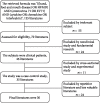Predicting Severe Enterovirus 71-Infected Hand, Foot, and Mouth Disease: Cytokines and Chemokines
- PMID: 32089650
- PMCID: PMC7013319
- DOI: 10.1155/2020/9273241
Predicting Severe Enterovirus 71-Infected Hand, Foot, and Mouth Disease: Cytokines and Chemokines
Abstract
Enterovirus 71 (EV71) is one of the most common intestinal virus that causes hand, foot, and mouth disease (HFMD) in infants and young children (mostly ≤5 years of age). Generally, children with EV71-infected HFMD have mild symptoms that resolve spontaneously within 7-14 days without complications. However, some EV71-infected HFMD cases lead to severe complications such as aseptic meningitis, encephalitis, acute flaccid paralysis, pulmonary edema, cardiorespiratory complication, circulatory disorders, poliomyelitis-like paralysis, myocarditis, meningoencephalitis, neonatal sepsis, and even death. The mechanism of EV71 pathogenesis has been studied extensively, and the regulation of host immune responses is suspected to aggravate EV71-induced severe complications. Recently, several cytokines or chemokines such as TNF-α, IFN-γ, IL-1β, IL-18, IL-33, IL-37, IL-4, IL-13, IL-6, IL-12, IL-23, IL-27, IL-35, IL-10, IL-22, IL-17F, IL-8, IP-10, MCP-1, G-CSF, and HMGB1 have been reported to be associated with severe EV71 infection by numerous research teams, including our own. This review is aimed at summarizing the pathophysiology of the cytokines and chemokines with severe EV71 infection.
Copyright © 2020 Weijian Zhang et al.
Conflict of interest statement
The authors have no conflicts of interest to declare.
Figures
References
-
- McMinn P., Lindsay K., Perera D., Chan H. M., Chan K. P., Cardosa M. J. Phylogenetic analysis of enterovirus 71 strains isolated during linked epidemics in Malaysia, Singapore, and Western Australia. Journal of Virology. 2001;75(16):7732–7738. doi: 10.1128/JVI.75.16.7732-7738.2001. - DOI - PMC - PubMed
Publication types
MeSH terms
Substances
LinkOut - more resources
Full Text Sources
Miscellaneous


